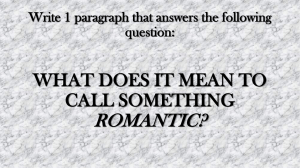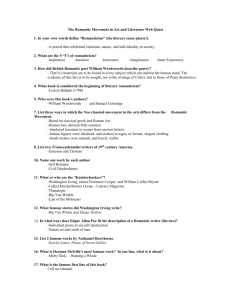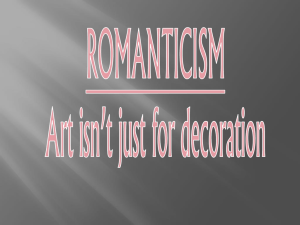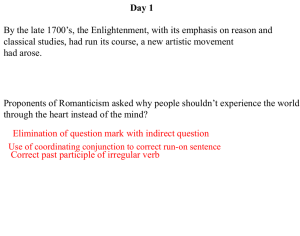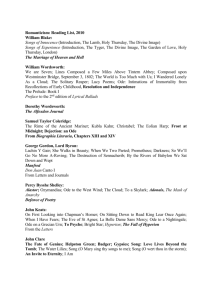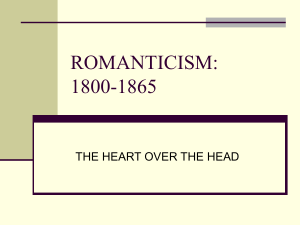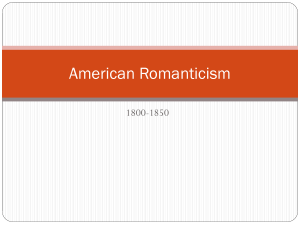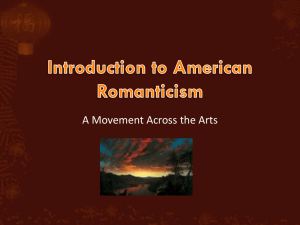Romanticism.doc - apeuro
advertisement
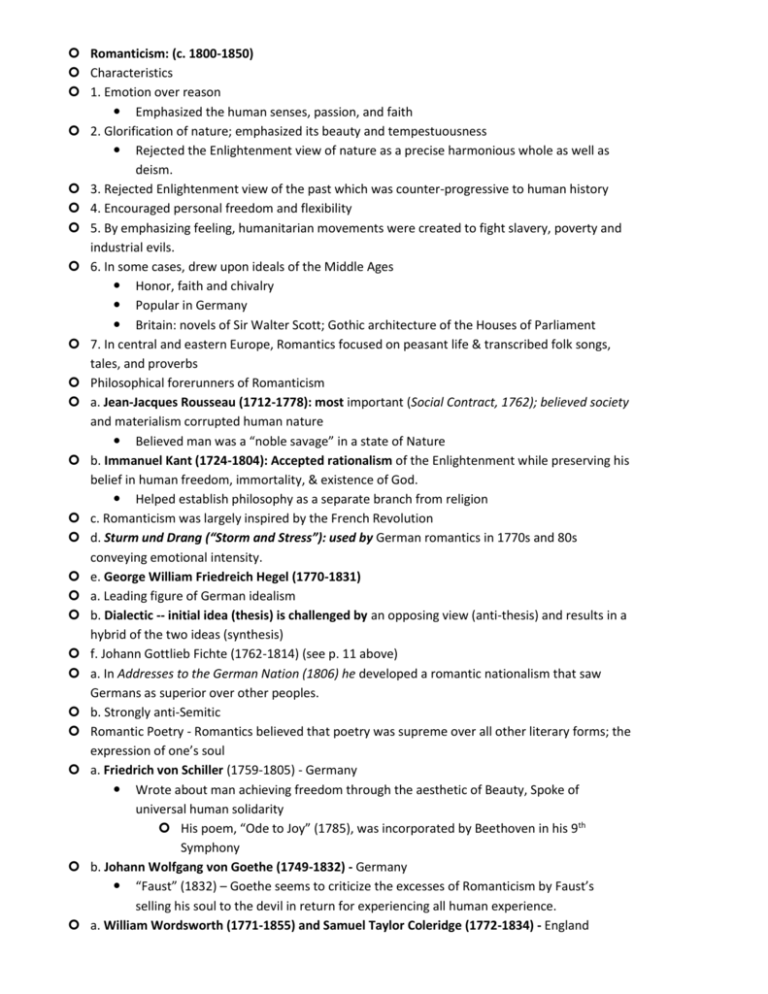
Romanticism: (c. 1800-1850) Characteristics 1. Emotion over reason Emphasized the human senses, passion, and faith 2. Glorification of nature; emphasized its beauty and tempestuousness Rejected the Enlightenment view of nature as a precise harmonious whole as well as deism. 3. Rejected Enlightenment view of the past which was counter-progressive to human history 4. Encouraged personal freedom and flexibility 5. By emphasizing feeling, humanitarian movements were created to fight slavery, poverty and industrial evils. 6. In some cases, drew upon ideals of the Middle Ages Honor, faith and chivalry Popular in Germany Britain: novels of Sir Walter Scott; Gothic architecture of the Houses of Parliament 7. In central and eastern Europe, Romantics focused on peasant life & transcribed folk songs, tales, and proverbs Philosophical forerunners of Romanticism a. Jean-Jacques Rousseau (1712-1778): most important (Social Contract, 1762); believed society and materialism corrupted human nature Believed man was a “noble savage” in a state of Nature b. Immanuel Kant (1724-1804): Accepted rationalism of the Enlightenment while preserving his belief in human freedom, immortality, & existence of God. Helped establish philosophy as a separate branch from religion c. Romanticism was largely inspired by the French Revolution d. Sturm und Drang (“Storm and Stress”): used by German romantics in 1770s and 80s conveying emotional intensity. e. George William Friedreich Hegel (1770-1831) a. Leading figure of German idealism b. Dialectic -- initial idea (thesis) is challenged by an opposing view (anti-thesis) and results in a hybrid of the two ideas (synthesis) f. Johann Gottlieb Fichte (1762-1814) (see p. 11 above) a. In Addresses to the German Nation (1806) he developed a romantic nationalism that saw Germans as superior over other peoples. b. Strongly anti-Semitic Romantic Poetry - Romantics believed that poetry was supreme over all other literary forms; the expression of one’s soul a. Friedrich von Schiller (1759-1805) - Germany Wrote about man achieving freedom through the aesthetic of Beauty, Spoke of universal human solidarity His poem, “Ode to Joy” (1785), was incorporated by Beethoven in his 9th Symphony b. Johann Wolfgang von Goethe (1749-1832) - Germany “Faust” (1832) – Goethe seems to criticize the excesses of Romanticism by Faust’s selling his soul to the devil in return for experiencing all human experience. a. William Wordsworth (1771-1855) and Samuel Taylor Coleridge (1772-1834) - England Deeply influenced by philosophy of Rousseau and the spirit of the early French Revolution. In 1798, both poets published Lyrical Ballads, one of most influential literary works in the history of the English language, Defied classic rules and abandoned flowery poetic conventions for ordinary language. Nature was a mysterious force from which the poet could learn Portrayed simple subjects in a highly idealized and majestic way b. Sir Walter Scott (1771-1832), Scottish Long narrative poems and historical novels, Represented the romantic’s interest in history Rob Roy (1817), Ivanhoe (1819): story of a fight between Saxon and Norman knights in medieval England c. Lord Byron (1788-1824) - England Embodied the melancholic Romantic figure, Died fighting for Greek independence against the Turks in 1824 d. Percy Bysshe Shelley (1792-1822) - England Prometheus Unbound (1820): Detailed the revolt of humans against a society that oppresses them Literature 2. Goethe a. Sorrows of the Young Werther Werther personified the Romantic hero who was misunderstood and rejected by society but stayed true to his inner feelings. His rejection by a girl whom he loved resulted in his suicide This novel influenced many others during this era with tragic stories of lovers b. Perhaps greatest of the German Romantic authors 3. Victor Hugo (1802-1885): Hunchback of Notre Dame; Les Miserables Romanticism in his novels was evident with his use fantastic characters, strange settings, and human emotions. 4. Grimm’s Fairy Tales: collection of German folk stories a. The Grimm brothers, Jakob and Wilhelm, were influenced by Herder’s views about preserving songs and sayings of German culture. b. Provides a strong example of how German nationalism and romanticism were tied together Art 1. Caspar David Friedrich (1774-1840), Wanderers Above the Mist (1818) Mystical view of the sublime power of nature was conveyed in many of his paintings 2. Eugène Delacroix (1796-1863) a. Most famous French romantic painter b. Interested in the exotic and dramatic use of color Liberty Leading the People (1830) is his most famous work for his portrayal of the 1830 Revolution in France 3. Théodore Géricault (1791-1824) a. Raft of the Medusa (1818-19): based on a shipwreck off the west coast of Africa b. Themes of power of nature and man’s attempt to survive its force 4. J. M. W. Turner (1775-1851) a. Depicted nature’s power and terror. b. Wild storms and sinking ships were favorite subjects c. Many paintings of landscapes, seascapes, sunrises and sunsets. 5. John Constable (1776-1837) Rural English landscapes in which human beings were at one with their environment. Liberty Leading the People Eugène Delacroix, 1830 Music (c. 1820-1900) 1. Romantic music places a strong connection with emotion as well as nationalism through the use of national folk songs 2. Ludwig van Beethoven (1770-1826) a. Transitional figure between the Classical and Romantic eras b. One of the first composers to covey inner human emotion through music c. Epitomized the genius who was not constrained by patronage (virtually all his predecessors) Many of his later works were written when he was deaf d. First composer to incorporate vocal music in a symphony by using the text to one of Schiller’s poems (“Ode to Joy”) in the last movement of his 9th Symphony. 3. Franz Schubert (1797-1828) Wrote hundreds of German songs (lieder) that wedded music and Romantic poetry. 4. Hector Berlioz (1803-1869) a. A major founder of programmatic music that sought to covey moods and actions via instrumental music b. Symphonie Fantastique is his masterpiece and is the first programmatic symphony 5. Frédéric Chopin (1810-49): wrote numerous piano works that highlighted Polish folk songs and dances Music (cont.) 7. Antonín Dvořák (1841-1904): Works utilized folk music of his native Bohemia 8. Giuseppi Verdi (1813-1901), greatest Italian opera composer 9. Richard Wagner (1813-1883), German opera a. Along with Verdi he is considered the greatest opera composer of the 19th century b. His development of the “music-drama” is often considered the culmination of the Romantic era c. German nationalist composer who strongly emphasized Germanic myths and legends 10. Peter Tchaikovsky (1840-1893) a. Most well-known of the Russian romantic composers; perhaps the most gifted European composer in the creation of beautiful melodies. b. Often used Russian folk songs in his symphonies, ballets (e.g. The Nutcracker and Swan Lake) and other works c. 1812 Overture (1882) and March Slav (1876) are but two examples of his use of folk songs and the creation of memorable melodies. 6. Franz Liszt (1811-1886): a. Many of his works reflected his native Hungarian music (e.g. Hungarian Rhapsody) b. Greatest piano virtuoso of mid-late 19th century c. Developed the symphonic poem (or tone poem), a single movement symphonic work that was based on a literary or pictorial idea. Architecture 1. The Romantic era returned to medieval ideals in certain respects. 2. Gothic revival architecture returned in some notable cases The architecture for the British Houses of Parliament (rebuilt in mid-1800s) is perhaps the most famous example G. Romanticism’s connection to politics and revolution a. Romantics believed in revolutionary movements that would give people more freedom and control over their lives b. Supported nationalistic movements that emphasized cultural traditions and languages of Europe’s varied peoples c. Revolutionary movements were highly idealized and probably not attainable in light of political realities of the era. d. The art of the period tended to idealize these movements National Movements 2. France: Eugene Delacroix a. Massacre at Chios, 1824 Portrays Greek Christians who seek independence as victims of Ottoman savagery b. Liberty Leading the People, 1830 Idealized portrayal of popular revolution with Marianne, bourgeois and proletariat revolutionaries. 3. Germany a. Disillusionment with the French Revolution and Napoleon pushed German romantics towards nationalistic views where individuals would be fulfilled by being part of a national culture, united by history b. Johann Gottfried von Herder rebelled against Enlightenment rationalism as he was a leader of the Sturm and Drang movement Urged Germans to study German literature and history as believed language was a key to national unity Believed an individual reached highest stage of development through a passionate connection with a national community—Volksgeist c. Sources such as Grimm’s Fairy Tales furthered the notion of a German culture National movements 4. Italy a. Popular revolution led by Mazzini and Garibaldi had strong idealistic and Romantic overtones b. Giuseppe Verdi’s operas evoked strong nationalist views Verdi was seen in some circles as the figure head for the Italian unification movement Some of his early operas can be seen as allegories for the Italian desire to rid Italy of its Austrian and other foreign oppressors In 1847, one of his nationalistic operas nearly sparked a massive riot 1859, the name “VERDI” was graffiti on walls throughout Italy, not only to celebrate the composer, but an acronym: Vittorio Emanuele Re (“king”) d’ Italia. In 12 years, Victor Emmanuel would be king of a united Italy. 5. The eventual failures of the Revolutions of 1848 led to disillusionment with Romantic goals that paved the way for the rise of Realism as a dominant new artistic movement

